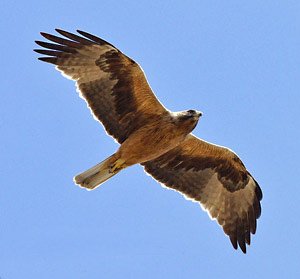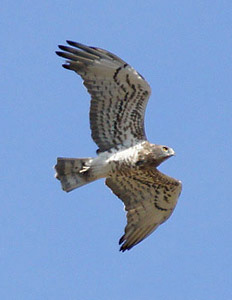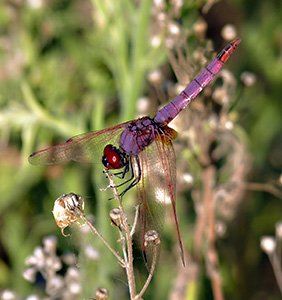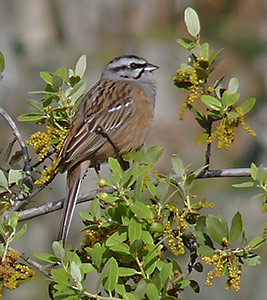 |
Strait of Gibraltar: W Europe's main bird migration funnel
 Booted Eagle Aquila pennata
© Santiago Villa
Booted Eagle Aquila pennata
© Santiago Villa
Long recognised for the remarkable concentrations of large soaring birds on active passage, our autumn tours are timed to coincide with the peak numbers and variety of raptors and storks crossing the Strait as they head to Africa. For birds and cetaceans this is also an East-West bottleneck between the Mediterranean and the Atlantic, leading to further diversity, while we also look for some of the rarer species, including butterflies and dragonflies, restricted to the southernmost tip of Europe.
The Strait of Gibraltar is simply a 'must see' for anyone interested in natural history in Europe. The narrowing of the mountainous southern tip of mainland Spain, leaving a gap of just 14km between Europe and Africa, provides ideal conditions for huge numbers of large migratory birds (and sometimes butterflies and dragonflies!) to concentrate and gain height before they take the plunge and head across the Strait. And the numbers are simply spectacular: up to 3,000 Black Storks, c. 80,000 White Storks,  Black Stork Ciconia nigra© Santiago Villa c. 125,000 Black Kites, 2,000+ Egyptian Vultures, 400-500 Montagu's Harriers, 18,000 Short-toed Eagles, 60,000-70,000 European Honey Buzzards, c. 30,000 Booted Eagles and 2,000 Eurasian Sparrowhawks are the main species recorded during the annual autumn counts, but there are many more. Hundreds of Ospreys, Western Marsh Harriers and Lesser Kestrels cross too, and other regular species include small numbers of Eurasian Hobby. This remarkable concentration, spread over several months, but peaking in numbers from the very end of August to mid September, naturally draws in rarities too, with some of the most notable being Rüppell's Vulture, Lanner Falcon and cirtensis Long-legged Buzzard, though the latter are now resident and breeding in very small number in the area too. Spanish Imperial and local Bonelli's Eagles occasionally appear, but it is a little later in the autumn when other raptor rarities tend to turn up and one would need to be watching, in the right places and right times, for some 3 months to see them! Despite these numbers, with thousands of birds crossing some days, since 85% of all the birds crossing do so after 9 in the morning, it won't just be gazing upwards for hours on end or early starts every day! Black Stork Ciconia nigra© Santiago Villa c. 125,000 Black Kites, 2,000+ Egyptian Vultures, 400-500 Montagu's Harriers, 18,000 Short-toed Eagles, 60,000-70,000 European Honey Buzzards, c. 30,000 Booted Eagles and 2,000 Eurasian Sparrowhawks are the main species recorded during the annual autumn counts, but there are many more. Hundreds of Ospreys, Western Marsh Harriers and Lesser Kestrels cross too, and other regular species include small numbers of Eurasian Hobby. This remarkable concentration, spread over several months, but peaking in numbers from the very end of August to mid September, naturally draws in rarities too, with some of the most notable being Rüppell's Vulture, Lanner Falcon and cirtensis Long-legged Buzzard, though the latter are now resident and breeding in very small number in the area too. Spanish Imperial and local Bonelli's Eagles occasionally appear, but it is a little later in the autumn when other raptor rarities tend to turn up and one would need to be watching, in the right places and right times, for some 3 months to see them! Despite these numbers, with thousands of birds crossing some days, since 85% of all the birds crossing do so after 9 in the morning, it won't just be gazing upwards for hours on end or early starts every day!
 Short-toed Eagle Circaetus gallicus © Santiago Villa Short-toed Eagle Circaetus gallicus © Santiago VillaBut the Straits are far from 'just' being the place to see active large bird migration in W Europe. The largely rugged coastline from Barbate in the west round to Algeciras Bay in the E is relatively underdeveloped and a haven for seabird and small bird migrants and other resident species. The endangered Northern Bald Ibis has been reintroduced to the area and established a breeding colony in 2011, while migrant terns and gulls, including the attractive Audouin's Gull and rare Lesser Crested Tern regularly use part of the enormous and protected Los Lances beach near Tarifa if left undisturbed by the kite-surfers! The dunes behind attract shorebirds too, including annual Eurasian Dotterel, while areas of salinas, such as further up the coast at Sancti Petri, attract a superb variety of shorebirds and gulls, often including Slender-billed Gull and Eurasian Spoonbills too. Seawatching can also be very productive here too, and can be combined with a little culture at sites such as Cape Trafalgar, allowing a brief opportunity for seeing marine birds such as Cory's Shearwater, Great Skua and a variety of terns on passage amongst others.
The interior of the peninsula is also a rugged area covered in one of the best-conserved tracts of native forest - principally of Cork Oak - in Spain, in the Alcornocales Natural Park. This just extends down onto the steep slopes which drop into the Strait at a couple of spots and provides excellent opportunities for finding forest species such as Firecrest, Crested Tit and the large Monarch and Two-tailed Pasha butterflies. For those interested in insects, the gorgeous Orange-winged Dropwing dragonfly started colonising Europe from Africa in 2007 and occurs in the area
 Violet Dropwing Trithemis annulata© John Muddeman as does the scarce Green Hooktail, while one of the true stars of the area is the rare Zeller's Skipper at its only European outpost. The numerous rock outcrops provide nesting sites for the rare Little and White-rumped Swifts, as well as showy Blue Rock Thrush, while with time, we might also take in a short visit to some interesting Roman Ruins on the coast, which naturally also lie under a flight path for birds heading S! Violet Dropwing Trithemis annulata© John Muddeman as does the scarce Green Hooktail, while one of the true stars of the area is the rare Zeller's Skipper at its only European outpost. The numerous rock outcrops provide nesting sites for the rare Little and White-rumped Swifts, as well as showy Blue Rock Thrush, while with time, we might also take in a short visit to some interesting Roman Ruins on the coast, which naturally also lie under a flight path for birds heading S!
The Strait of Gibraltar experiences a remarkable weather phenomena related to the influence of the Atlantic and Mediterranean seas. Winds of variable force blow almost permanently, either from the west, the poniente, or from the east, the levante, with an average of just 2-3 days a year with none. With large birds not wanting to be blown out into the Atlantic, the sometimes gale force easterlies can lead to a massive build-up of soaring birds before it subsides. Consequently, with little movement on days of strong levante we either travel to sites on the lee side, or further inland, and when it subsides, we get into position to experience what we hope will be a mass passage crossing. Naturally, this strongly dictates when and where we go on a daily basis in order to maximise our observations of the visible migration.
The tour will consequently be based around observing the extraordinary migration spectacle, but as we never ignore the other wildlife, will also serve as an introduction to the reptiles, butterflies and dragonflies of the region as well, though in September, the flowering plants are very few and far between.
For a provisional itinerary, please see the Spainbirds page for this tour.
"I enjoyed the tour very much! The birds were great, as were the logistics. And I really liked the Hotel Antonio – great choice! :-D The BIG reason for the tour's success was John's guiding. I told him “you are in the right line of business”, which I consider to be a high compliment. And, I meant it. He is everything one looks for in a guide – he has outstanding knowledge of the birds (and lepidoptera and herps!) and knows where to find them. More importantly, John is ALWAYS client-focused. His “customer care” was always in evidence, both in the field and when arranging logistics. I think John is an outstanding representative of Spainbirds, and I just wanted you to know." Dick A. (USA) September 2017 "Thank you so much for an amazing week of birding. We really had a fantastic time and could not have wished for a better Guide. Your passion and enthusiasm towards your craft is infectious and made the birding all the more enjoyable. Thanks so much for your patience too! We really appreciate you taking the time to explain some of the more interesting facts about the birds, the area and the habitats; we really learned a lot!" Dawn P. & Maureen P. (UK) September 2016
 Rock Bunting Emberiza cia© John Muddeman Rock Bunting Emberiza cia© John Muddeman
Strait of Gibraltar: W Europe's main bird migration funnel
Leader: John Muddeman for Spainbirds Nature Tours
2019 Dates:
Sat. 14 – Fri. 20 Sep 7-day tour
2020 Dates: Please enquire for details.
ANYTIME DATES by request; Spring options are also available.
Price: 1,450€ per person, including half-board, en suite accommodation at a rural guesthouse or hotel, tapas / picnic lunches, minibus transport throughout, all entry fees and the services of John Muddeman as leader. A single-room supplement of 195€ is applicable.
The cost is for a land-based tour. Flights and travel insurance (obligatory) are the responsibility of the client, though we can help with bookings. We start / finish at Malaga airport.
All payments have to be made in Euros to Spainbirds Nature Tours S.L.
For booking, please click on the Spainbirds Booking Form, or contact me directly (see my contact details below). The Spainbirds office will then advise you of the payment details and terms.
Booking information: either follow the link above or feel free to contact John Muddeman for further details and a booking form, or indeed if you have any queries about this tour.
| E-mail: |
|
|
| Office phone: | (+34) 918 989195 |
| Mobile phone: | (+34) 649 608747 |
|
| Address: |
C/ Alcocer 1, 1-C
28214 Fresnedillas de la Oliva,
Madrid
Spain
|
|